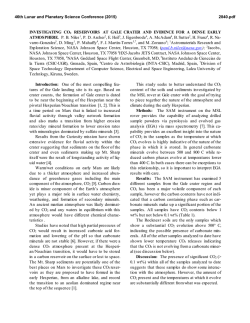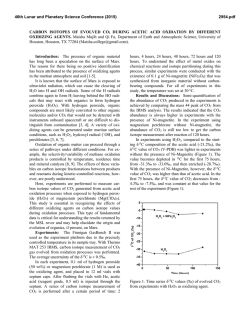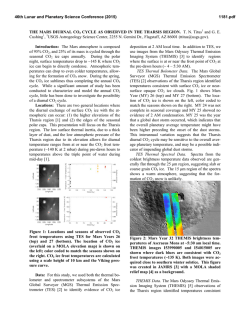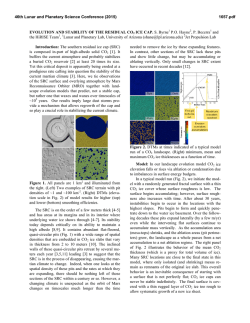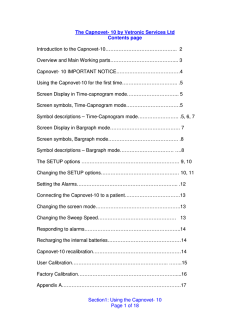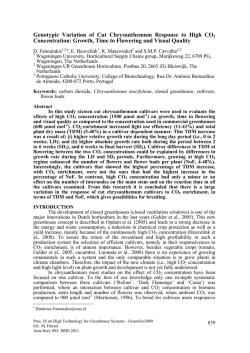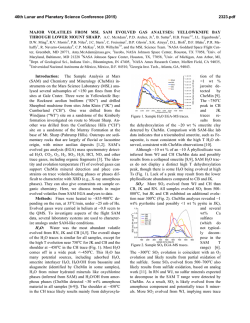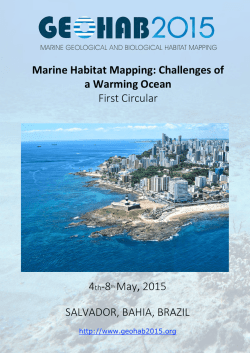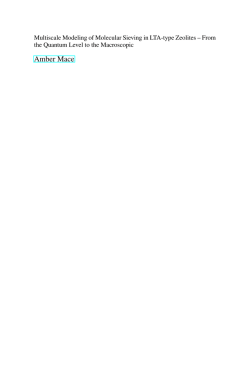
effects of elevated seawater co2 concentration on the meiofauna
Special Issue, pp. 17-22 (2007) 17 EFFECTS OF ELEVATED SEAWATER CO2 CONCENTRATION ON THE MEIOFAUNA Haruko Kurihara*, Atsushi Ishimatsu* and Yoshihisa Shirayama** Key words: CO2, decreased pH, nematoda, harpacticoid copepoda. ABSTRACT An increase in atmospheric CO2 concentration leads to a rise in CO 2 concentrations and a decrease in pH of the ocean surface water due to continuous gas exchange between air and seawater, which may have serious impacts on neritic marine organisms. In this study, we assessed the impacts of elevated CO 2 concentrations on meiobenthic organisms by exposing them to seawater equilibrated with air (control: CO 2 concentration 380 ppm) or CO 2-enriched air (2,000 ppm higher than control, CO 2 concentration predicted by the year 2300) for 56 days in microcosms. We observed no significant differences in the abundance of total meiofauna, nematodes, harpacticoid copepods (including adults and copepodites) and nauplii by the end of the experiment. These results suggest that the projected atmospheric CO 2 concentration in the year 2300 does not have acute effects on the meiofauna. However, further studies are needed to evaluate longerterm effects of elevated CO 2 on meiobenthic organisms. INTRODUCTION The atmospheric concentration of carbon dioxide (CO 2) has increased from the pre-industrial level of 280 parts per million (ppm) to 380 ppm as a result of anthropogenic CO2 emission associated with industrialization [11]. The resulting global warming has already impacted terrestrial and marine ecosystems [18, 24], and a further rise in temperature is predicted to intensify sea surface stratification and drastically alter marine ecosystem [1, 19]. In addition to the indirect effects of CO 2 due to global warming, recent studies have revealed direct effects of CO 2 on terrestrial ecosystems, and have predicted serious impacts on interactions between plants and insects [4, 7]. Due to continuous gas exchange between air and seawater [22], an increase in atmospheric CO 2 concentrations will raise CO 2 concentrations at the ocean Author for Correspondence: Haruko Kurihara. E-mail: [email protected]. *Institute for East China Sea Research, Nagasaki University, 1551-7 Tairamachi, Nagasaki, 851-2213, Japan. **Seto Marine Biological Laboratory, Kyoto University, 459 Shirahama, Nishimuro, Wakayama, 649-2211, Japan. surface, and decrease seawater pH through the dissociation of carbonic acid formed by the increased CO2 [5]. The atmospheric CO 2 concentration is predicted to increase to above 2,100 ppm, and thereby reducing the pH of the ocean surface water by about 0.77 units by the year 2300 [5]. These chemical changes in seawater likely have significant impacts on neritic marine organisms. Most published studies on the effects of CO 2 on marine organisms have focused on calcification responses to elevated seawater CO 2 concentration (for review, see Supporting Online Material of Feely et al. [8]). Riebesell et al. [17] also demonstrated that the growth rate of marine diatoms Thalassiosira punctigera and Rhizosolena cf. alata increased with CO 2 concentration. These previous studies mostly employed short-term exposure protocols and only very few evaluated long-term effects of increased CO 2 on marine organisms. Recently Michaelidis et al. [15] reported that the growth and metabolic rates of the marine mussels Mytilus galloprovincialis decreased when exposed to CO 2 -acidified seawater (pH 7.3) for 3 months. Shirayama and Thornton [21] demonstrated that growth of sea urchins Hemicentrotus pulcherrimus and Echinometra mathaei was suppressed by 6-month exposure to seawater equilibrated with CO 2 -enriched air (580 ppm). It is therefore conceivable that long-term exposure of marine organisms to elevated CO2 concentration seawater for several generation could potentially result in decreases of population size. In the present study, we incubated meiobenthic communities under elevated CO2 conditions (2,000 ppm above ambient) for 56 days to investigate changes in abundance and biomass of nematodes and harpacticoid copepods. Meiofauna is suitable for studying long-term effects because of its short generation time, rapid growth, and high abundance in a small area. In addition, despite their small size, meiobenthic faunas are important in the energy flow of marine benthic ecosystems [9]. Here, we focused on nematodes and harpacticoid copepods because they usually account for more than 90% of the total meiofauna in mud environments [10], and owing to their confinement in the oxidized layers of sediment (usually in the top 1 cm, [6]), they may be more suscep- Special Issue (2007) MATERIAL AND METHODS Sediments were sampled with a Smith McIntyre grab from the seafloor (approximately 10 m in depth) of the Tanabe Bay, in the Kii Peninsula, Japan (33° 42.2’N, 135° 22.9’E) on 30 January 2001. The top 5 cm layer was used for the experiment. The experiment was conducted for two months (from 1 February to 29 March, 2001) in an indoor microcosm system. The sediments were homogenized by stirring and were placed in six microcosms (capacity 30L) to a depth of 7 cm and covered with seawater. Microcosms were placed in a flow-through container into which coastal seawater was pumped continuously. Air was supplied at a rate of 500 ml min-1 to the water in three microcosms, (CO 2 concentration 360 ppm, control groups) whereas the water in the other three microcosms were aerated with CO 2 -enriched air (CO 2 concentration 2,000 ppm higher than the air, CO2 groups). The flow rates of air (500 ml min-1) and CO2 (1 ml min1 ) were controlled using flow meters (Kofloc). The pH and temperature of water in each microcosm was measured daily using a pH meter (Horiba, D-25). No food was supplied. The entire volume of seawater in each microcosm was renewed once a week throughout the experiment. The photoperiod was set to 14L:10D. To monitor changes in the meibenthic community, sediment was sampled on days 0 (untreated cores), 7, 14, 21, 28, and 56. At each sampling, one sediment core (1-cm deep) was taken from each microcosm using a plastic syringe, the tip of which was cut off to make a cylinder (2.0 cm internal diameter). Sediment samples were preserved in 5% borax-buffered formalin seawater. Rose Bengal was added to stain the meiofaunae. The samples were sieved through stainless steel sieves with mesh size of 500, 250, 125, 63, and 32 µm, and the number of meiofauna was counted under a dissecting microscope. The biomass of the meiofauna was calculated by using the standard ash-free dry weight per individual as reported by Shirayama [20]. Treatment effects were evaluated statistically using Student t-test and two-way ANOVA. Values are given as means ± S.D.. each microcosm varied between 13.0°C to 17.8°C (Figure 1). The difference in water temperature was less than 0.1°C between any two microcosms throughout the experiment. The average seawater pH values of the control and CO2 groups were 8.20 ± 0.05 and 7.40 ± 0.07, respectively (Figure 1). 2. Effects on the abundance and biomass of meiofauma The abundance of total meiofauna was significantly lower in the CO2 groups than in the control of the same day only on day 7 (t-test, p < 0.05, Figure 2). The total biomass fluctuated in both control and CO2 groups during the experiment (2-way ANOVA, p < 0.05, Figure 2), but there was no difference between the two groups at any given day of observation throughout the experiment (t-test, Figure 2). The composition of meiobenthic community in this study consisted of nematodes (67.8 ± 7.5%), harpacticoid copepods (24.4 ± 4.4%), nauplii larvae (4.3 ± 2.7%), ostracods (1.6 ± 1.6%), turbellarians (1.9 ± 1.4%) and polychaeta (0.1 ± 0.3%). The foraminiferans were excluded from our analysis because of their fragile nature. The abundance and the biomass of the two dominant taxa, nematodes and copepods (including adults and copepodites), were further investigated to examine possible changes in meiofauna composition. The abundance of nematodes varied significantly with time in both control and CO2 groups (2-way ANOVA, p < 0.05, Figure 3), whereas there was no difference between the 20 Temperature (°C) tible to the direct and indirect effects of seawater CO2 . We also investigated the effects on nauplius larvae, because the early developmental stages are thought to be particularly sensitive to environmental changes [14]. 18 16 14 Control CO2 12 10 8.4 8.2 8.0 pH 18 7.8 7.6 7.4 RESULTS 1. Temperature and pH During the experiment, seawater temperature of 7.2 0 7 14 21 28 Days 35 42 48 56 Fig. 1. Mean seawater temperature and pH of the control and CO2 microcosms during the experimental period. H. Kurihara et al.: Effects of Elevated Seawater CO2 Concentration on the Meiofauna Abundance (103 ind. m-2) Control CO2 600 400 200 Abundance (103 ind. m-2) 600 800 Control CO2 * 400 200 Abundance (103 ind. m-2) 200 800 600 400 200 Copepods 100 0 0 7 14 21 28 56 Days Fig. 2. Change in abundance and biomass of total meiofauna in control and CO2 groups from day 0 to day 56. Initial abundance of total meiofauna was 385 × 103 ± (16 × 103) ind. m-2 (control) and 475 × 103 ± (147 × 103) ind. m-2 (CO2 groups). Initial biomass of total meiofauna was 437 × 197 mgC m-2 (control) and 521 ± 400 mgC m-2 (CO2 microcosms). Mean ± SD of three replicate microcosms. * Significant difference between control and CO2 groups (p < 0.05, t-test). 300 Abundance (103 ind. m-2) Biomas (mg C m-2) Nematodes 0 0 1000 0 19 Nauplii 200 100 0 0 7 21 14 28 56 Days two except on day 7 (t-test, p < 0.05, Figure 3). There was a decreasing tendency in nematode biomass in both groups (2-way ANOVA, p < 0.05, Figure 4), although no significant difference was detected between the two groups at any given day of observation (t-test, Figure 4). No difference in the abundance of harpacticoid copepods was either detected throughout the experiment between the two groups (t-test, Figure 3). On day 7, the biomass of harpacticoid copepods in CO2 groups was significantly higher than control groups, whereas the reverse was true on day 21 (t-test, p < 0.05, Figure 4). No difference in the abundance of harpacticoid nauplii was detected throughout the experiment between the two groups (t-test, Figure 3). The abundance of other components of meiofauna, such as polychaetes, ostracods, and turbellarians, were also unaffected by CO 2 . Fig. 3. Changes in the abundance of nematodes, harpacticoid copepods and nauplii in sediment in control and CO2 groups from day 0 to day 56. Initial abundance of nematodes was 274 × 103 ± (16 × 103) ind. m-2, copepods was 90 × 103 ± (18 × 103) ind. m-2, and nauplii was 10 × 103 ± (3 × 103) ind. m-2 (control). Initial abundance of nematodes was 302 × 103 ± (86 × 103) ind. m-2, copepods was 122 × 103 ± (25 × 103) ind. m-2, and nauplii was 31 × 103 ± (22 × 103) ind. m-2 (CO2 groups). Mean ± SD of three replicate microcosms. * Significant difference between control and CO2 groups (p < 0.05, t-test). of CO 2 tolerance. The most abundant sizes of nematodes and harpacticoid copepods were between 250 and 125 µm (Figures 5, 6). For nematodes, there was a significant difference between treatments in the abundance of 250- to 125 µm size classes on day 7 (t-test, p < 0.05, Figure 5c), but not in the other size classes (Figure 5). For harpacticoid copepods, no significant differences were observed between treatments in any size class throughout the experiment (Figure 6). 3. Effects on the different sizes of meiofauna DISCUSSION We analyzed the size structure of nematodes and harpacticoid copepods to evaluate the size dependency Our results suggest that atmospheric CO2 concen- Special Issue (2007) 20 -2 Control CO2 (a) Control 15 CO2 3 150 100 50 0 800 Biomass (mg C m-2) 20 Nematodes Abundance (10 ind. m ) Biomass (mg C m-2) 200 10 5 0 80 Copepods (b) 60 600 * * 400 40 20 200 0 0 7 21 14 28 56 0 300 Days Fig. 4. Change in the biomass of nematodes and harpacticoid copepods in control and CO2 groups from day 0 to day 56. Initial abundance of nematodes was 132 ± 17 mgC m-2 and copepods was 282 ± 203 mgC m-2 (control). Initial abundance of nematode was 310 ± 367 mgC m-2 and copepods was 133 ± 55 mgC m-2 (CO2 groups). Mean ± SD of three replicate microcosms. * Significant difference between control and CO2 groups (p < 0.05, t-test). (c) 200 100 0 0 tration projected by the year 2300 (2,000 ppm higher than the control) does not induce lethal effects on most meiofaunae, at least within 56 days. In contrast, Shirayama and Thornton [21] showed that increased mortality of sea urchins and a gastropod after 6 months, when they were exposed to only 200 ppm above ambient or 580 ppm CO 2 . Similarly, we observed increased mortality of shrimps Palaemon pacificus exposed to 1,000 ppm CO 2 for 30 weeks and to 2,000 ppm CO 2 concentrations for 15 weeks (submitted). Thus, CO 2 tolerance differs markedly among marine organisms. The apparent higher tolerance of the benthic meiofauna may be attributable to several factors. First, the sea urchins, gastropod and shrimps are epibenthos, exposing themselves to ambient seawater, whereas the organisms examined in the present study largely confine themselves in sedimentary mud. Because of larger fluctuations of CO2 concentration in pore water, species dwelling in sediments may be more tolerant to CO2 than pelagic organisms [16]. Second, calcified marine organisms such as snails, echinoderms and crustaceans are thought to be more sensitive to CO 2 than other organisms due to the high sensitivity of CO2 effects on calcification mechanisms [8]. Specific difference in the response to elevated CO 2 may change community 200 7 14 21 28 56 (d) 150 100 50 0 60 (e) 40 20 0 0 7 14 21 28 56 Days Fig. 5. Changes in the abundance of nematodes of different size classes: (a) > 500 µm, (b) 500-250 µm, (c) 250-125 µm (d) 125-63 µm, and (e) 63-32 µm in control and CO2 groups from day 0 to day 56. Mean ± SD of three replicate microcosms. * Significant difference between control and CO2 groups (p < 0.05, t-test). H. Kurihara et al.: Effects of Elevated Seawater CO2 Concentration on the Meiofauna (a) Control -2 Abundance (10 ind. m ) 10 3 CO2 5 0 50 (b) 40 30 20 10 0 150 (c) 100 50 0 0 50 7 14 21 7 14 21 Days 28 56 (d) 40 30 20 10 0 30 (e) 20 10 0 0 28 56 Fig. 6. Changes in the abundance of harpacticoid copepods of different size classes: (a) > 500 µm, (b) 500-250 µm, (c) 250-125 µm (d) 125-63 µm, and (e) 63-32 µm in control and CO2 groups from day 0 to day 56. Mean ± SD of three replicate microcosms. * Significant difference between control and CO2 groups (p < 0.05, t-test). 21 structure, and thereby have ecosystem-level consequences. Even though meiobenthos are not lethally affected by elevated CO 2 , it is highly possible that raised CO 2 have sub-lethal effects on reproduction, metabolism and growth rate. Michaelidis et al., [15] reported that long-term exposure (3 months) of the marine mussels to CO 2 -acidified seawater (pH 7.3) resulted in a depression of respiration rate. Similarly, reduced growth rate and feeding activity under low pH were observed in clams and oysters [2, 3]. When sea urchin eggs were reared under elevated CO2 levels, the fertilization rate of the eggs tended to decrease with increasing CO 2 concentration [13]. In the present study, the abundance of small-sized nematodes (Figure 5e) and nauplius embryos (Figure 3) never disappeared throughout the experiment, although their abundance fluctuated in both control and CO 2 microcosms. This suggest that may have been successful recruitments under elevated CO2 conditions, and therefore elevated CO 2 had not impacted the reproduction of nematodes and harpacticoid copepods. However, it is possible that, there could have been a change in the species composition of nematodes or harpaticoid copepods, in spite of no observed change in the abundance or biomass of meiofauna in the elevated microcosms. Indeed, Takeuchi et al. [23] demonstrated in CO2 tolerance between marine nematode species. Analyses of nematodes and harpacticoids to a lower taxonomic level are needed to more closely evaluate impacts of raised CO2 on these meiofaunal taxa. Investigating biological impacts of elevated CO 2 is of importance in the context of understanding environmental impacts of not only ocean acidification due to increasing atmospheric CO2, but also of potential seepage from sub-seabed geological CO2 storage, for which no scientific information is currently available [12]. Biological impacts should differ depending on the extent (from geologically localized to spatially dispersed), duration (slow gradual to sudden intermittent), the magnitude of CO 2 flux leaked, and the phase of CO 2 (supercritical, liquid or gas), let alone the local fauna and flora of seepage sites. However, endobenthic organisms may well be subjected to much higher CO 2 concentrations than the projected maximum concentrations of atmospheric CO 2 . Appropriate experimental protocols must be employed to evaluate the risk of potential seepage from sea-bed geological storage, because the expected hazards are distinctly different from the impact of CO2 injection into mid-water depths [12]. In conclusion, the results demonstrated that the increased seawater CO2 concentration used in the present study does not have acute impacts on the abundance and biomass of the meiofauna. Yet, it is possible that the meiofauna is sublethally affected when exposed to raised Special Issue (2007) 22 CO 2 concentration for longer durations and that the meiobenthic community structure changes due to differences in CO2 tolerance among species. Further studies are needed to understand the future impacts of increasing atmospheric CO 2 on the marine ecosystem. 12. 13. ACKNOWLEDGEMNT We gratefully acknowledge Mr. K. Okita and Mr. Y. Yamamoto for their help in sampling the sediments. We are thankful to Mr. M. Oota, Mr. K. Tsugoshi and Mr. T. Yamamoto for helping set up the microcosms. We thank Dr. G. Itani for advice on statistical analysis. 14. 15. REFERENCES 1. Arrigo, K.R., Robinson, D.H., Worthen, D.L., Dunbar, R.B., DiTullio, G.R., VanWoert, M., and Lizotte, M.P., “Phytoplankton Community Structure and the Drawdown of Nutrients and CO2 in the Southern Ocean,” Science, Vol. 283, pp. 365-367 (1999). 2. Bamber, R.N., “The Effects of Acidic Seawater on Young Carpet-Shell Clams Venerupis Decussata (L.) (Mollusca: Veneracea),” Journal of Experimental Marine Biology and Ecology, Vol. 108, pp. 241-260 (1987). 3. Bamber, R.N., “The Effects of Acidic Seawater on Three Species of Lamellibranch Mollusk,” Journal of Experimental Marine Biology and Ecology, Vol. 143, pp. 181191 (1990). 4. Bezemer, T.M. and Jones, T.H. “Plant-Insect Herbivore Interactions in Elevated Atmospheric CO2: Quantitative Analyses and Guild Effects,” Oikos, Vol. 82, pp. 212-222 (1998). 5. Caldeira, K. and Wickett, M.E., “Anthropogenic Carbon and Ocean pH,” Nature, Vol. 425, pp. 365 (2003). 6. Coull, B.C. and Bell, S.S., “Perspectives of Marine Meiofauna Ecology,” In Livingstone, R. J. (Eds), Ecological Processes in Coastal and Marine Systems, Plenum Publishing Corporation, New York, pp. 189-216 (1979). 7. Coviella, C.E. and Trumble, J.T., “Effects of Elevated Atmospheric Carbon Dioxide on Insect-Plant Interactions,” Conservation Biology, Vol. 13, No. 4, pp. 700-712 (1999). 8. Feely, R.A., Sabine, C.L., Lee, K., Berelson, W. Kleypas, J., Fabry, V.J., and Millero, F.J., “Impact of Anthropogenic CO2 on the CaCO3 System in the Oceans,” Science, Vol. 294, pp. 362-366 (2004). 9. Gerlach, S.A., “On the Importance of Marine Meiofauna for Benthos Communities,” Oecologia, Vol. 6, pp. 179190 (1971). 10. Giere, O., “The Impact of Oil Pollution on Intertidal Meiofauna. Field Studies after the La Coruna-Spill, May 1976,” Les Cahiers de Biologie Marine, Vol. 20, pp. 231-251 (1979). 11. Houghton, J.T., Ding, Y., Griggs, D.J., Noguer van der Liden, M.P.J., Dai, X., Maskell, K., and Johnson, C.A., 16. 17. 18. 19. 20. 21. 22. 23. 24. Climate Change 2001: The science of climate change, Cambridge Cambridge University (2001). IPCC, Carbon Dioxide Capture and Storage, Cambridge Cambridge University (2005). Kurihara, H. and Shirayama, Y., “Effects of Increased Atmospheric CO2 on Sea Urchin Early Development,” Marine Ecology Progress Series, Vol. 274, pp. 161-169 (2004). Kurihara, H., Shimode, S., and Shirayama, Y., “Effects of Raised CO2 Concentration on the Egg Production Rate and Early Development of Two Marine Copepods (Acartia Steueri and Acartia Erythraea),” Marine Pollution Bulletin, Vol. 49, pp. 721-727 (2004). Micahelidis, B., Ouzounis, C., Paleras, A., and Pörtner, H.O., “Effects of Long-Term Moderate Hypercapnia on Acid-Base Balance and Growth Rate in Marine Mussels Mytilus Galloprovincialis,” Marine Ecology Progress Series, Vol. 293, pp. 109-118 (2005). Pörtner, H.O., Langenbuch, M., and Reipschläger, A., “Biological Impact of Elevated Ocean CO 2 Concentrations: Lesson from Animal Physiology and Earth History,” Journal of Oceanography, Vol. 60, pp. 705-718 (2004). Riebesell, U., Wolf-Gladrow, D.A., and Smetacek, V., “Carbon Dioxide Limitation of Marine Phytoplankton Growth Rates,” Nature, Vol. 361, pp. 249-251 (1993). Root, T.L., Price, J.T., Hall, K.R., Schneider, S.H., Rosenzweig, C., and Pounds, J.A., “Fingerprints of Global Warming on Wild Animals and Plants,” Nature, Vol. 421, pp. 57-60 (2003). Sarmiento, J.L., Hughes, T.M.C., Stouffer, R.J., and Manabe, S., “Simulated Response of the Ocean Carbon Cycle to Anthropogenic Climate Warming,” Nature, Vol. 393, pp. 245-248 (1998). Shirayama, Y., “Size Structure of Deep-Sea Meio- and Macrobenthos in the Western Pacific,” Internationale Revue der Gesamten Hydrobiologie, Vol. 68, No. 6, pp. 799-810 (1983). Shirayama, Y. and Thornton, H., “Effect of Increased Atmospheric CO2 on Shallow Water Marine Benthos,” Journal of Geophysical Research, Vol. 110, C09S08 (2005). Takahashi, T., Feely, R.A., Weiss, R.F., Wanninkhof, R. H., Chipman, D.W., Sutherland, S.C., and Takahashi, T. T., “Global Air-Sea Flux of CO2: An Estimated Based on Measurements of Sea-Air pCO2 Difference,” Proceedings of the National Academy of Sciences USA, Vol. 94, pp. 8292-8299 (1997). Takeuchi, K., Fujioka, Y., Kawasaki, Y., and Shirayama, Y., “Impacts of High Concentration of CO2 on Marine Organisms: a Modification of CO 2 Ocean Sequestration,” Energy Conversion & Management, Vol. 38, pp. S337-S341 (1997). Walther, G.-R., Post, E., Convey, E., Menzel, A., Parmesan, C., Beebee, T.J.C., Fromentin, J.-M., HoeghGuldberg, O., and Bairlein, F., “Ecological Responses to Recent Climate Change,” Nature, Vol. 416, pp. 389-395 (2002).
© Copyright 2025
